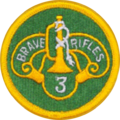US cavalry

The US cavalry was the cavalry of the US Army . Because of its key role in land claiming in the Wild West , it became part of the founding myth of the United States. In the course of the 20th century, the still existing cavalry associations replaced their horses with motor vehicles or helicopters, but for reasons of tradition they still use the name cavalry in the association name .
history
In the Continental Army under George Washington there were four regiments of Light Dragoons, which were rarely used in regimental units during the War of Independence , but mostly served in smaller detachments for reconnaissance and courier services. They were dissolved at the end of the war. Shortly before the outbreak of the war of 1812 , two regiments of dragoons were set up. Two regiments of cavalry were added to these in the 1830s and one of the Mounted Rifles in 1846 . In 1856 the short-lived US Camel Corps was established.
When the Civil War broke out , all regiments were uniformly renamed cavalry and their number increased to twelve. In addition, there were numerous other regiments set up by the Union and the remaining states, so that at the end of the war there were over 250 state and federal regiments in the field, while the southern states only had around 170 regiments. In the course of the war, the cavalry often fought dismounted as riflemen and thus anticipated the development of the First World War. So at the beginning of the Battle of Gettysburg, John Buford's cavalry occupied and defended an important hill, which contributed significantly to the Union's victory.
After the surrender at Appomattox , the number of federal regiments was reduced to twelve again (two of them with African-American replacement of the team ranks, the so-called Buffalo Soldiers ). Mostly deployed as small detachments scattered across the country, the cavalry played a key role in conquering the west and became a part of the founding myth of the United States, although compared to even the most famous of their battles, the Battle of Little Bighorn under General George Armstrong Custer the wars before and after that had little more than the character of a skirmish.
In the Spanish-American War , the future President Theodore Roosevelt led the 1st US Volunteer Cavalry Regiment to a loss-making victory in the Battle of San Juan Hill. The "Rough Riders" fought on foot.
After the US entry into the First World War in 1917 in was trench warfare on the Western Front a kavalleristischer use no longer possible. During the defense of the Philippines against the Japanese invaders in 1942 during World War II , the 26th Cavalry Regiment rode the last attack in US military history, but the majority of the US cavalry was already mechanized by this time . During the Second World War and the Korean War , the cavalry fought in all theaters of war, mostly as part of the armored force.
In the Vietnam War , the 1st Cavalry Division was deployed as an airborne force equipped with helicopters , but was converted back into a tank division in 1975, which, like every active division of the US Army, has an Army Aviation Brigade with combat and transport helicopters and is currently the 5th, 7th ., 8th, 9th and 12th Cavalry Regiments (divided into three brigades). Together with the three independent "regiments" (actually they are brigades) 2nd Cavalry Regiment , 3rd Cavalry Regiment and 11th Armored Cavalry Regiment , they continue the cavalry tradition to this day in the association name, albeit apart from the band and a squad of the 1st Division the soldiers are not mounted.
badge
1st Cavalry Division shoulder badge
2nd Cavalry Regiment shoulder badge
3rd Cavalry Regiment shoulder badge
Shoulder badge of the 11th Armored Cavalry Regiment
The US Cavalry's badge color is yellow. Before the civil war it was orange for the Dragoons and green for the hunters on horseback.
Large appliances
M1 Abrams (with clearing blade) of the 5th CR, 1st CD
Sikorsky UH-60 of the 227th Aviation Regiment, 1st Air Cavalry Brigade, 1st CD, fighting forest fires
2nd ACR's Stryker Armored Vehicle
M3 Bradleys of the L- Troop , 3rd ACR, Operation Desert Shield
Humvee of the 11th ACR with BGM-71 TOW converted to represent the enemy as a BRDM-2
literature
- Tom Clancy , Armored Cavalry. The associated American tank units , Munich 1997
- Liliane and Fred Funcken , L'uniforme et les armes des soldats des États-Unis. Les guerres d'indépendance, de Sécession, du Mexique. L'épopée du Far-West (2). La cavalerie et l'artillerie. Tournai 1980.
- Gregory JW Urwin, The United States Cavalry: An Illustrated History, 1776-1944 , Poole, Dorset 1983









